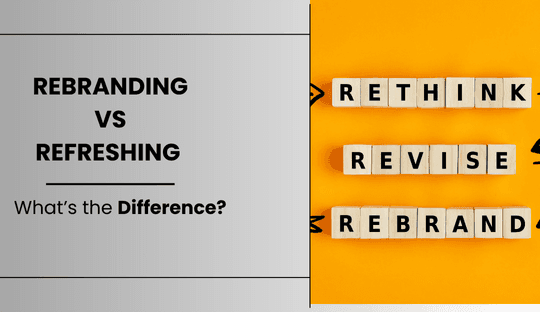
Rebranding vs. Refreshing: What’s the Difference?
In the fast-paced world of business, maintaining a strong brand presence is crucial for success. For companies like Flykez CO, a leading creative brand company in North Macedonia, understanding the distinction between rebranding and refreshing can help determine the best approach to stay competitive and relevant. This article delves into the differences between rebranding and refreshing, providing valuable insights and strategies for effective implementation.
Understanding Rebranding
1. Comprehensive Overhaul
Rebranding involves a comprehensive overhaul of a company’s identity. This process includes significant changes to the brand’s logo, name, messaging, mission, and overall visual identity. Rebranding is often pursued when a company undergoes a major shift in its business model, target market, or core values. It’s a strategic move to reposition the brand in the marketplace and create a new perception among consumers.
2. Strategic Transformation
Rebranding is a strategic transformation aimed at addressing fundamental changes within the company or industry. It’s not just about aesthetics; it involves redefining the brand’s purpose, vision, and market positioning. For Flykez CO, rebranding might include a complete redesign of its website, a new logo, updated brand messaging, and a refined approach to digital marketing and UI & UX design.
3. Long-Term Commitment
Rebranding requires a long-term commitment and substantial investment. It’s a process that involves extensive research, planning, and execution. Companies must be prepared for potential risks, as rebranding can alienate existing customers if not executed properly. However, when done correctly, it can rejuvenate the brand and open new avenues for growth.
Exploring Refreshing
1. Visual and Tactical Updates
Refreshing, on the other hand, focuses on updating the brand’s visual elements and marketing strategies without altering its core identity. This process includes minor tweaks to the logo, color palette, typography, and marketing materials. The goal is to modernize the brand’s appearance and keep it relevant without changing its fundamental essence. Also Read About Innovative Rebranding Techniques for the Digital Age
2. Maintaining Brand Equity
Refreshing aims to maintain the brand equity that the company has built over time. It’s a way to keep the brand up-to-date with current trends and consumer preferences while preserving the existing brand recognition and loyalty. For Flykez CO, a brand refresh might involve updating the website’s design, refining the user interface for better experience, and implementing new SEO strategies to enhance online visibility.
3. Cost-Effective Approach
Compared to rebranding, refreshing is a more cost-effective approach. It requires less time and resources, making it suitable for companies that want to stay competitive without undergoing a complete transformation. Refreshing allows businesses to adapt to market changes and consumer expectations swiftly and efficiently.
When to Choose Rebranding
1. Major Market Shifts
Rebranding is ideal when a company faces major market shifts or changes in its target audience. For instance, if Flykez CO decides to expand its services globally, a rebrand might be necessary to appeal to a broader audience and convey a more universal brand message.
2. Negative Brand Perception
If a brand has suffered from negative perception or a crisis, rebranding can help rebuild its image and regain consumer trust. A new brand identity can signify a fresh start and a commitment to positive change.
3. Mergers and Acquisitions
Rebranding is often necessary during mergers and acquisitions to create a unified brand identity. It helps in integrating the strengths of both entities and presenting a cohesive image to the market.
When to Opt for Refreshing
1. Outdated Visuals
If the brand’s visual elements appear outdated but the core identity remains strong, refreshing is the way to go. Updating the logo, website design, and marketing materials can make the brand look contemporary and appealing.
2. Market Trends
Refreshing is suitable when there is a need to align with current market trends and consumer preferences. It allows the brand to stay relevant and competitive without drastic changes.
3. Enhancing User Experience
For companies like Flykez CO, improving the user experience through a website refresh or UI & UX enhancements can significantly impact customer satisfaction and engagement. Small tweaks in design and functionality can lead to better user interactions and higher conversion rates.
Conclusion
Understanding the differences between rebranding and refreshing is crucial for making informed decisions that align with your business goals. For Flykez CO, leveraging these strategies can help maintain a strong brand presence in North Macedonia and beyond. Whether opting for a comprehensive rebrand or a subtle refresh, the key is to stay true to the brand’s core values while adapting to the ever-changing market landscape. Embrace the right approach to ensure your brand continues to thrive and resonate with your audience.
For more information on how Flykez CO can help with your rebranding needs, visit www.flykez.com.
